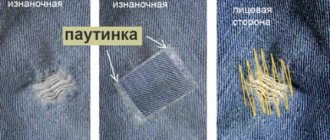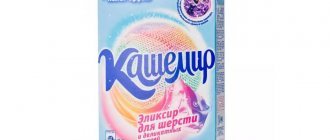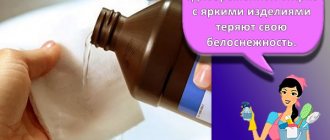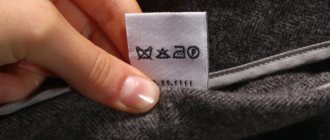Linen is a dense material made from natural fibers that can be bleached well by various means, including folk ones.
White linen items are beautiful, but easily soiled. They have to be washed and bleached quite often. In order not to spoil such products, you should know how to properly bleach linen at home.
To do this, use high-quality oxygen bleaches and powders with bleaching particles, as well as folk remedies - acetic acid, hydrogen peroxide, persalt, ammonia, turpentine, bleach, soda, potassium permanganate.
Laundry soap
The simplest and most affordable method of whitening, which, by the way, is used in restaurants, is to wash stains with laundry soap. The tablecloth must be moistened, hung on a rope, and then all dirt must be washed off.
The soaped textiles must sit for several hours, and then all marks are washed out by hand. All that remains is to wash the item in the washing machine, adding a small amount of bleach.
General recommendations
- Sort items by color: colored items should not be washed with white or light-colored items.
- Carefully read the composition of the material on the label. It also contains care instructions. Do not wash linen clothes together with items made from other fabrics.
- Gentle hand washing is recommended, but linen can also be washed in an automatic machine on one of the gentle cycles.
- Since linen absorbs water well, do not load the washing machine too much; if there are too many clothes and they absorb most of the water, the clothes will not wash well.
- You need to rinse linen clothes very carefully, since detergent particles remaining in the fibers can damage the structure of the fabric.
- If you need to use chemicals to remove heavy stains, check their effect on an inconspicuous area of the product - collar, inner seam, pocket. If the structure of the fabric is not disturbed and it does not “shed”, the entire product can be processed.
- Linen should also be dried and ironed according to the rules.
Dish gel
Most often, yellow spots remain from fats and vegetable oil. Dish gel perfectly dissolves fats and will help remove even the most stubborn stains.
You should soak the tablecloth in warm water, adding a few tablespoons of the product. The item should lie in the solution for several hours, or preferably overnight. In the morning, you can wash the tablecloth in the washing machine or by hand.
Machine washable
Read about: how to wash clothes for a newborn.
Modern models of automatic machines have many modes that allow you to safely wash linen products. You can choose one of the gentle modes: “Hand wash”, “Delicate fabrics”.
- A special feature of washing in a machine is the need to turn on the additional rinse function so that the smallest particles of detergent do not remain on the fabric.
- You need to load the drum 2/3 full, as flax absorbs a lot of moisture and swells.
- The number of revolutions during spinning should be reduced to a minimum so that many wrinkles do not form and it is easier to smooth out the product.
Ammonia and glycerin
Often yellow stains from coffee or tea appear on a snow-white tablecloth. You need to mix 1 part ammonia and 4 parts liquid glycerin, which can be purchased at a pharmacy.
Apply the mixture to the stain and leave for an hour. After the time has passed, wash the stain with laundry soap.
You can also use a mixture of glycerin and salt, taken in equal parts. The composition is applied to the stain, left for about 30 minutes, and then the stains are washed away.
Method 1. Hydrogen peroxide
Synthetics, wool, silk, cotton differ in fiber structure, elasticity, strength, and different options are chosen for each.
You can return the white color without boiling as follows:
- Washed woolen clothes are soaked for 3-4 hours in 12 liters of hot water with the addition of 250 g of salt, 30 g of washing powder, 3 liters of peroxide.
- Cotton, linen, and synthetic products are bleached for 3-4 minutes. in the washing machine. In this case, the temperature of the liquid should be at least 75-80 °C. Add 5-7 ml of peroxide to 10-15 liters of detergent.
- Tulle that has turned gray from washing or time will be helped by keeping it in a solution with 2 tbsp. l. peroxide, 1 tbsp. l. ammonia for 3-5 minutes.
Boiling
Boiling is an old method of our great-grandmothers, which helps to whiten various yellow stains and restore the whiteness of the fabric.
For boiling you will need:
- 100 g brown soap.
- Large grater.
- Boil down.
- A wooden stick to stir laundry.
- Water.
Grate half a bar of soap and dissolve in warm water. Fill a large saucepan or boiling pot with water and pour the soap solution into it. The soap must dissolve well, otherwise it may leave yellowish stains on the laundry.
When the soap solution begins to boil, immerse the tablecloth in it and boil, stirring constantly. After boiling, the tablecloth is rinsed in cold water. When boiling, you can add lemon juice or salt to the pan to make the tablecloth dazzling white.
How to bleach linen
Washing with bleach is the easiest way. However, this method should not be used too often, as bleach ages and destroys the fabric. Frequent use can cause linen items to look worn out and unattractive.
In addition, not every item is safe to wash with chlorine bleach. Therefore, be sure to check the washing conditions on the label or tag. If you choose this method, choose high-quality and more gentle oxygen bleaches without chlorine.
Ammonia is an effective and gentle way to get rid of yellowness. Add alcohol to soapy water with powder at the rate of one tablespoon of ammonia per liter of water. Soak the linen fabric in the resulting solution for several hours. Instead of ammonia, you can use turpentine.
Add two tablespoons of turpentine to soapy water, soak the flax for 8-10 hours and then wash as usual. Turpentine and ammonia give linen items freshness and a snow-white color. For greater effect, choose special powders for white fabrics with a bleaching effect.
To bleach linen, you can add a little blue to the rinse water. Today, in a household chemicals and cosmetics store you can easily find a special blue dye for hand and machine washing, as well as similar fabric softeners. This product will effectively eliminate yellowness and return the white color to things.
For bleaching, use a weak solution of vinegar or hydrogen peroxide. In the first case, flax is soaked in 7% vinegar for two to three hours. Then the items are washed in the usual way and rinsed thoroughly in clean, cool water.
Hydrogen peroxide is a longer method, since the material will have to be soaked for a day. Dilute three tablespoons of peroxide in a liter of water. This is a very effective method, and after soaking things become fresh and white. They will look like new!
A little potassium permanganate is added to hot water along with washing powder, and the color of the water becomes slightly pink. After normal washing, linen items are placed in this solution and covered with polyethylene. When the water dries, take out the flax and rinse several times.
Many people are interested in how flax was bleached in the old days. Previously, ash was used for this. The material was placed in hot water mixed with wood ash and left in a warm place for 8-12 hours. The linen was then washed and laid out in the sun to fade during the day. After this, the fabric was washed again and beaten with special rollers.
Yolk and glycerin
You can remove yellow marks from a white tablecloth using raw yolk and liquid glycerin.
Beat the yolk until foamy. And then the same amount of glycerin is introduced into it. The mixture should have a uniform consistency. All contaminated areas are lubricated with the composition. After 30-40 minutes, the item is rinsed and washed by hand with bleaching powder.
Whitening using baking soda
The main method, which has clear advantages over all others, has always been the method using baking soda. For approximately 7 liters of water at approximately 40 degrees, you need to take 6-7 tablespoons of baking soda and stir until completely dissolved. You can also pour in one tablespoon of hydrogen peroxide, this will give the solution more whitening effect. Soak the contaminated item in this solution and do not touch it for two hours. Apply a small amount of baking soda to heavily soiled areas and rub thoroughly. In case of strong yellowing, it is allowed to boil the items briefly in the solution used. It is worth remembering that it is not advisable to use boiling on wardrobe items, as well as on synthetic fabrics and wool products. It is best to boil bedding, kitchen and bath towels and socks.
Kerosene
But if gentle folk remedies do not help to cope with pollution, then you can correct the situation with the help of kerosene or household gasoline. These substances are suitable for particularly persistent and long-standing stains.
To remove stains, you must use only highly purified household gasoline. Regular automobile fuel is not suitable for these purposes. You can buy household gasoline at a hardware store.
The product is applied liberally and left for about 20-30 minutes. After this, the textiles are rinsed and washed well. It is best to air dry the product to remove the unpleasant odor.
How to bleach linen fabric at home?
Linen has long been used to make clothing, because the natural fabric is environmentally friendly and does not cause allergic reactions or rashes. Due to the ability to allow air to pass through, the fabric allows the skin to breathe, which is a particularly important factor when choosing clothes.
In addition to its natural, positive properties, linen also has an attractive appearance. Light, light-colored fabric looks great as a sundress, light dress or men's trousers. Such clothing helps to reject the sun's rays and provides a feeling of comfort in hot weather.
In addition to clothing, linen fabric is usually used as decorative elements of the room. Kitchen curtains made of linen and formal tablecloths for dining or coffee tables are considered common. Linen has been used in everyday life for a long time, but it has gained particular popularity these days, when natural and environmentally friendly products have come into fashion.
Among the positive properties, it should be noted the wear resistance and strength of the fabric. Such clothes do not require special, intensive care, but will last for many years. The only thing that can happen to linen fabric is the disappearance of the rich white shade. But there are many options and methods to return your favorite item to its original appearance.











